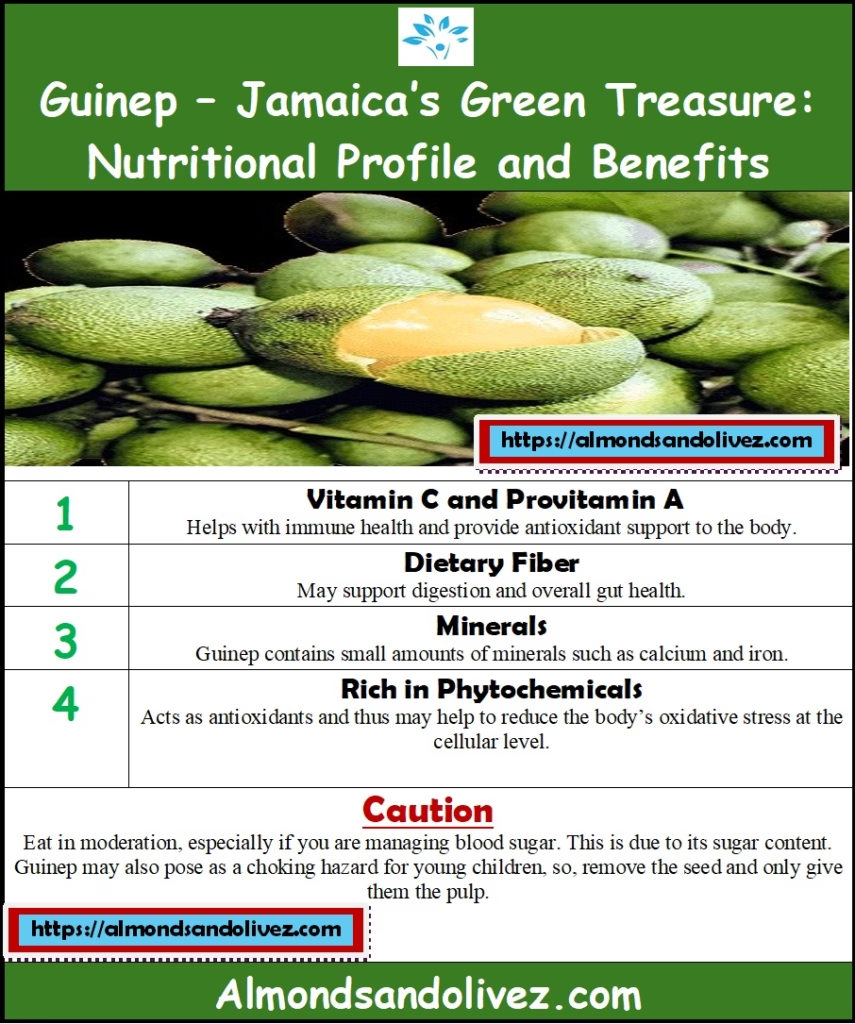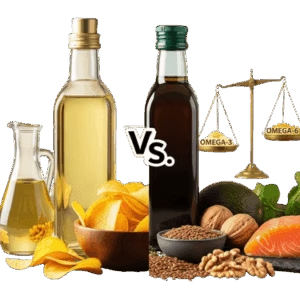TABLE OF CONTENTS
When I was a child, I used to eat Guinep like it was going out of season (which it was 😊). Why? One of our neighbours had a tree with a large part of it hanging over our yard. So, in Guinep season, we (my friends and I) ate morning, noon, and night, or until we started feeling sick at times.
Those were the good old days. But I never thought about the health benefits of this little fruit; my main intention was to eat as many as I could, and if my stomach allowed.
However, this little, green seasonal fruit is a favourite of many Jamaicans, as you can find it on the streets, sold by vendors, especially at stoplights. While I may not have thought about the nutritional value of this little fruit, science dictates it is packed with nutrients, including antioxidants. Let’s Discuss!
The Discussion
Guinep or Melicoccus bijugatus is from the Sapindaceae family, or what is commonly known as the soapberry family – the same family as lychee. It is commonly known as Guinep, mamoncillo, Spanish lime, genip, quenepa in some regions (Bailey and E.Z., 1976; Stoffels, 2008).
It is usually small, green, and surprisingly sweet and is a seasonal favourite across Jamaica and the wider Caribbean. Locally known as “Guinep,” “skin-up,” “mamoncillo,” “kenip” or “genip,” this fruit grows on the tropical tree Melicoccus bijugatus and is eaten fresh from the shell for its jelly-like pulp, which surrounds a large seed (Bailey and E.Z., 1976; Stoffels, 2008).
Beyond its nostalgic street-side appeal, scientific interest in Guinep has grown because of its pulp, seed, and extracts, which reportedly contain vitamins, dietary fiber, and phenolic compounds that show antioxidant and cardio-protective activities in animal studies.
In this article, we will explore Guinep, its texture, how it is usually eaten, nutritional profile, scientific benefits, some practical takeaways, how to pick and store, as well as some culinary ideas.
You can watch the video about Guinep, its benefits, and more in the video below:
Guinep – Jamaica’s Little Green Treasure:
- Texture, taste, and how Jamaicans eat it.
- Nutritional profile.
- Scientific Health Benefits.
- Antioxidant and Phenolic Activity.
- Gastrointestinal and Astringent Properties.
- Cardiovascular/Blood Pressure Effects.
- Safety and Toxicity of Guinep.
- Who should take caution in eating Guinep?
- Practical Takeaways.
- How to Pick and Store Guinep.
- Culinary Ideas for Guinep.
Taste, Texture and How Jamaicans Eat It
Guinep’s thin green skin is cracked or bitten open to reveal soft, pale orange pulp that clings to a large seed. The pulp tastes sweet and tart with floral notes. The fruit is compared somewhere between lychee and lime and is commonly sucked from the seed or gently chewed.
In Jamaica, vendors sell bunches of Guinep during the harvest season. The fruit is mostly eaten raw, made into beverages, and sometimes used in preserves.
Sweet, tangy, and sticky — Guinep is best eaten fresh and is typically sold in bunches along Jamaica’s roadsides during the summer.
Guinep’s Nutritional Profile – Pulp and Seed
Nutrient values for Guinep vary by origin, ripeness, and laboratory method, but multiple sources report consistent themes:
- Vitamins: Particularly vitamin C and provitamin A carotenoids (beta-carotene precursors). These support immune function and act as antioxidants (Wilson et al. 2019; Morton, 1987).
- Dietary fiber: The pulp contributes fiber, which supports digestion and gut health (Wilson et al. 2019; Morton, 1987).
- Minerals: Small amounts of calcium, phosphorus, and iron have been reported (Morton, 1987; Leterme et al., 2006).
- Phytochemicals: Multiple studies identify phenolic acids, flavonoids, and other polyphenols in guinep tissues — compounds linked to antioxidant capacity (Bystrom, 2012).
It should be noted that the large central seed is generally discarded or sometimes roasted and eaten in some cultures after processing. The seed oil and proteins have been explored in research, but are not common dietary staples.
You can read more on vitamins and minerals in the articles below:
- Our ABCs – A Complete Vitamins Overview
- Why Minerals?
- Understanding Micro and Macronutrients – Getting to the Nut of the Matter
Guinep’s Scientific Health Benefits
Like so many other fruits, Guinep does have its share of health benefits. While most research previously focused on one of its famous relatives – lychee, interest in Guinep and its nutritional benefits has been growing in recent years. Below are the most cited areas of scientific interest for Guinep, with references to laboratory and animal research.
- Guinep’s Antioxidant and Phenolic Activity
Researchers measuring total phenolic and flavonoid contents have found that guinep pulp and other tissues have measurable antioxidant activity (free-radical scavenging) in vitro. Phenolic compounds are thought to underlie many of guinep’s traditional medicinal uses (Wilson et al. 2019; Bystrom et al. 2009).
- Guinep’s Gastrointestinal and Astringent Traditional Uses
Guinep reportedly have gastrointestinal benefits due to both its fiber content and astringent properties, especially in the seed (Goldstein et al., 2000; Hyams et al., 1988). Additionally, the ratio of glucose to fructose that is in the tissue of the pulp may also assist with alleviating some gastrointestinal issues, such as irritable bowel syndrome (Goldstein et al., 2000; Hyams et al., 1988).
As such, some regions use it traditionally for mild diarrhea or as an astringent. However, traditional claims do not equate to proven clinical effectiveness (Bystrom et al., 2009). So, while guinep is considered a healthy fruit, it is not a medicine.
- Guinep’s Cardiovascular and Hypertension Effects (animal studies)
Work led by researchers in the Caribbean (including teams at The University of the West Indies) has explored guinep extracts for cardiovascular effects. An aqueous guinep extract produced hypotensive (blood-pressure-lowering) effects in rat models, likely mediated by endothelium-dependent vasorelaxation and nitric-oxide-related pathways (Nwokocha, C.R. et al. 2020).
Additionally, separate animal studies also report cardio-protective effects in models of myocardial injury. These findings are promising, but remain preclinical — human trials are required before clinical claims can be made.
Furthermore, the pulp and seeds reportedly contain many different phytochemical compounds like epicatechin and catechin. It also contains flavonoids, which act like antioxidants and anti-inflammatory agents. These compounds may benefit those suffering from asthma, diarrhea and hypertension (Nwokocha, C.R et al. 2020).
Guinep’s Safety and Toxicity
Report suggests that the common edible portions of Guinep (pulp) do not display acute toxicity in laboratory models at doses tested; however, some parts (raw seeds) may contain components requiring proper processing, and anecdotal digestive upsets are occasionally reported. As with many traditional foods, safety is context dependent (amount, preparation, individual sensitivity) (Wilson et al., 2019).
It may also pose as a choking hazard, especially where children are concerned. As such, special caution must be taken when giving it to children to eat. Either give them only the pulp (the fleshy area) by removing the seed, or chew it up a bit before giving it to them.
Like many fruits, Guinep is typically sweet; as such, it has a high sugar content. Therefore, it should be eaten in moderation, especially for those managing blood sugar.
Who Should Take Caution?
- Children: The seed poses a choking hazard; remove pulp from the seed for young children.
- Allergies and sensitivities: If you have food allergies, introduce guinep cautiously. People with conditions requiring strict sugar control (e.g., diabetes) should count fruit sugar within their total daily carbohydrate plan.
How to Pick, Store and Prepare Guinep?
- Picking/choosing: Choose fruits that are full, firm and free of obvious bruising. The outer skin is green even when ripe; maturity is judged by ease of cracking and the fullness of pulp.
- Storage: Keep unpeeled guinep in cool, dry conditions and consume within a few days. They do not store as long as many temperate fruits.
- Preparation: Wash first. Crack or bite the skin to access pulp; suck the pulp off the seed, or remove pulp with a spoon for children to prevent choking. Use the pulp in juices, smoothies or chilled beverages.
Guinep’s Culinary Ideas
While the most common way of consuming guinep is simply eating it as is, over the years, people have found other ways of enjoying this little, powerful fruit. Please see below for some culinary ideas that have been explored when it comes to the consumption of Guinep.
Guinep juice: Blend pulp with water, strain, and sweeten lightly with honey. Chill and serve over ice.
- Guinep smoothie: Pulp + banana + plain yogurt + ice — quick breakfast or post-workout snack.
- Infused syrup/cocktails: Make a reduced guinep syrup for mocktails or cocktails (use conservatively).
Guinep is versatile — sweet, tangy, and hydrating. So, enjoy them when they are in season. Also, always remove seeds and supervise young children.
Guinep – Practical Health Takeaways (Evidence-Based)
- Guinep is an excellent source of vitamin C and fiber: Adding guinep to a varied diet can provide vitamin C and dietary fiber, supporting immune function and digestion.
- Contains antioxidants (polyphenols): Lab studies show antioxidant potential, which could help reduce oxidative stress at a cellular level, but human clinical evidence is limited.
- Potential cardioprotective signals in animals: Animal experiments (rats) suggest guinep extracts can lower blood pressure and show cardioprotective activity; these are promising leads but not yet grounds for clinical recommendations in humans.
- Moderation and context: Like other fruits, guinep contributes sugar (natural) and should be part of a balanced intake. Some cultural uses of seeds or concentrated extracts may require processing for safety.
Illustrative Summary
Here is an illustrative summary of GUINEP’S NUTRITIONAL PROFILE and SCIENTIFIC BENEFITS.
Let’s Sum Up!
Guinep is more than just a delicious seasonal treat. It thrives in tropical climates, and the fruit is culturally embedded in Jamaica’s summer street food culture. Seasonal harvests support small vendors and local markets.
It provides vitamin C, fiber and polyphenolic antioxidants and has shown interesting cardio-protective and hypotensive signals in preclinical studies. However, most studies are pre-clinical; as such, more human studies are recommended.
Eating guinep as part of a varied diet is reasonable and likely beneficial for micronutrients and fiber. You can also enjoy them as is, as well as in juices and smoothies. However, children and those with allergies should avoid it, especially seeing that it can become a choking hazard for young children.
So, now that we have explored Guinep, its nutritional profile and scientific benefits and ways to store and enjoy them. Have you ever consumed guinep? If so, how was it? And did you ever consider its nutritional benefits? Share it nuh!
You can read more about vitamins, minerals, iron and fiber in the articles below: You can also watch the video about guinep and its benefits, plus more via the link below.
- H.; Bailey, E.Z.; the staff of the Liberty Hyde Bailey Hortorium. 1976. Hortus third: A concise dictionary of plants cultivated in the United States and Canada. Macmillan, New York.
- Bystrom, Laura & Lewis, Betty & Brown, Dan & Rodriguez, Eloy & Obendorf, Ralph. (2009). Phenolics, Sugars, Antimicrobial and Free-Radical-Scavenging Activities of Melicoccus bijugatus Jacq. Fruits from the Dominican Republic and Florida. Plant foods for human nutrition (Dordrecht, Netherlands). 64. 160-6. 10.1007/s11130-009-0119-y.
- Bystrom, L. M. (2012). The potential health effects of Melicoccus bijugatus Jacq. fruits: Phytochemical, chemotaxonomic and ethnobotanical investigations. Fitoterapia, 83(2), 266–271. DOI:10.1016/j.fitote.2011.11.018, https://www.sciencedirect.com/science/article/abs/pii/S0367326X11002942?via%3Dihub
- Goldstein, R., D. Braverman, and H. Stankiewicz. 2000. Carbohydrate malabsorption and the effect of dietary restriction on symptoms of irritable bowel syndrome and functional bowel complaint. Isr. Med. Assoc. J. 2000(2):583–587.
- Hyams, J.S., N.L. Etienne, A.M. Leichtner, and R.C. Theuer. 1988. Carbohydrate malabsorp tion following fruit juice ingestion in young children. Pediatrics 82(1):64–68.
- Leterme, P., Buldgen, A., Estrada, F., & Londoño, A. M. (2006). Mineral content of tropical fruits and unconventional foods of the Andes and the rain forest of Colombia. Food Chemistry, 95(4), 644–652. DOI:10.1016/j.foodchem.2005.02.003, https://www.sciencedirect.com/science/article/abs/pii/S030881460500138X?via%3Dihub
- Morton, J. F. (1987). Mamoncillo. In Fruits of warm climates (pp. 267–269). Julia F. Morton. https://www.growables.org/information/TropicalFruit/MamoncilloMorton.htm. Accessed on 10 November 2025.
- Nwokocha, C.R., Gordon, A., Palacios, J. et al. Hypotensive and antihypertensive effects of an aqueous extract from Guinep fruit (Melicoccus bijugatus Jacq) in rats. Sci Rep 10, 18623 (2020). https://doi.org/10.1038/s41598-020-75607-3
- Stoffels, Karin (September 2008). “Soap Nut Saponins Create Powerful Natural Surfactant”. Personal Care Magazine. Jeen International Corporation. Archived from the original on 2011-06-15
- Wilson, J., Goldson-Barnaby, A., & Bailey, D. (2019). Melicoccus Bijugatus (guinep): Phytochemical Properties, Associated Health Benefits and Commercial Applications. International Journal of Fruit Science, 20(4), 659–666. https://doi.org/10.1080/15538362.2019.1669517.





